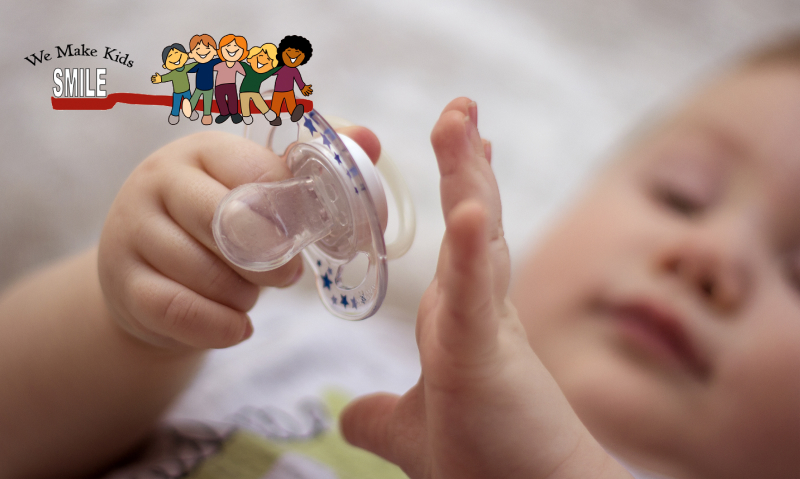What Parents Should Know About “Pacifier Teeth”
Have you ever heard of “pacifier teeth” syndrome? If you’re a parent of an infant or toddler, you may have read or heard that pacifiers, bottles, and thumbsucking can wreak havoc on your child’s smile. In reality, the truth isn’t so black and white.
Before you throw away your baby’s pacifiers, here is the lowdown on what you should know about pacifier teeth syndrome and safe pacifier use.
Pacifiers are not the enemy.
Before diving into pacifier teeth syndrome, it’s important to know that pacifiers are not bad nor are they inherently dangerous to your child’s smile.
Pacifiers can be incredibly beneficial tools for babies and their parents. They’ve been used since 1900 as a way of soothing and comforting babies. In fact, the first modern pacifier was called the “Baby Comforter.”
Pacifiers benefit babies by:
- Gently encouraging self-soothing
- Helping with the weaning process
- Reducing the risk of SIDS
Pediatric care authorities including the American Academy of Pediatrics (AAP) recommend and even encourage the use of pacifiers as long as some basic safety guidelines are followed.
How to Safely Use a Pacifier
In alignment with AAP guidelines on pacifier use, here are a few tips for safely offering a pacifier to your baby.
- Use a pacifier after your baby has been feeding well for a month.
- Offer a pacifier during naps or bedtime to reduce the chance of SIDS.
- Don’t tie the pacifier to your child’s body (i.e. wrist) or their crib.
- Don’t force the use of a pacifier.
- Don’t dip pacifiers in sweets to encourage use.
- Replace pacifiers at manufacturer’s recommendation.
- Follow manufacturer’s instructions on sanitizing pacifiers.
- Use pacifiers with a one-piece design and a 1.5-inch minimum shield.
Most children naturally wean themselves off of pacifiers and thumbsucking behaviors, but sometimes these behaviors persist after a few years. This brings us to the issue of pacifier teeth syndrome.
Prolonged Pacifier Use and Pacifier Teeth Syndrome
When pacifier use or thumsbucking behaviors continue beyond two to four years of age, pacifier teeth syndrome can develop. This is a form of malocclusion associated with the prolonged use of a pacifier or bottle as well as habitual thumbsucking.
Most children get their front baby teeth (incisors and cuspids) between six months and two years of age. The front teeth are naturally the most affected by pacifier use and thumbsucking. These actions can cause the baby teeth to become crooked and physically change the alignment of a child’s bite. Typically this results in a case of an open bite, causing the front teeth to jut outward even when the mouth is closed.
Pacifier teeth and an open bite can lead to future orthodontic issues, especially when thumbsucking behavior continues past the age of four or five and the child begins to get their adult teeth.
How Pacifier Teeth Syndrome Is Treated
An experienced pediatric dentist can help diagnose your child’s pacifier teeth and develop a treatment plan. Pacifier teeth typically develop slowly, and many parents don’t notice there is an issue until malocclusion is very apparent. This is a great example of why taking your child to see a pediatric dentist every six months starting at one year of age is highly recommended. Their dentist will be able to notice any signs of trouble before it’s obvious and before any permanent damage has occurred.
The first step in treating pacifier teeth is to curb the behavior. You’ll need to gradually wean your child away from relying on a pacifier or sucking on their thumb. Once the behavior is halted, their pediatric dentist can determine what action needs to take place.
In mild cases with only baby teeth present, sometimes the issue will solve itself. In more severe cases, interceptive orthodontic care may be necessary to reshape your child’s smile before more adult teeth erupt. Interceptive orthodontic care may require two phases of treatment: early care while baby teeth are present and application of braces in the future.
Avoid pacifier teeth and other early orthodontic trouble by choosing a long-term pediatric dental home.
Developing a long-term relationship with a pediatric dental practice is the best way to safeguard your child’s rapidly growing smile. This encourages regular dental appointments, fosters a relationship of trust between kids and dental care professionals, and reduces the risks of many dental problems in children, including pacifier teeth.
The We Make Kids Smile dental care team can help guide you through caring for your child’s smile at home, provide in-office exams, cleanings, and treatments, and monitor how your child’s smile is developing. Our pediatric dentists can guide parents on weaning kids from prolonged pacifier use and thumbsucking habits as well as treat the results of pacifier teeth.
For more information on pacifier teeth or to schedule an appointment for your child, you can call your preferred We Make Kids Smile office or use this online form.
